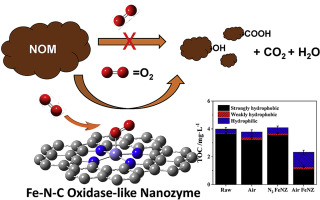当前位置:
X-MOL 学术
›
Water Res.
›
论文详情
Our official English website, www.x-mol.net, welcomes your
feedback! (Note: you will need to create a separate account there.)
The Fe-N-C oxidase-like nanozyme used for catalytic oxidation of NOM in surface water.
Water Research ( IF 11.4 ) Pub Date : 2020-01-09 , DOI: 10.1016/j.watres.2020.115491 Hankun Yang 1 , Xue Wu 1 , Lei Su 2 , Yiming Ma 3 , Nigel J D Graham 4 , Wenzheng Yu 1
Water Research ( IF 11.4 ) Pub Date : 2020-01-09 , DOI: 10.1016/j.watres.2020.115491 Hankun Yang 1 , Xue Wu 1 , Lei Su 2 , Yiming Ma 3 , Nigel J D Graham 4 , Wenzheng Yu 1
Affiliation

|
The removal of natural organic matter (NOM), particularly humic substances (HS) from surface waters during drinking water treatment is necessary to avoid various water quality problems in supply, such as the formation of disinfection by-products. As an alternative to conventional processes (e.g. coagulation), and in the light of the rapidly increasing applications of nanozyme in bio-catalysis, a novel Fe-N-C oxidase-like nanozyme (FeNZ) has been prepared and used to catalyze the oxidative degradation of NOM during simple aeration. Using humic acid (HA) as a model NOM it was found that the HA removal (as TOC) was increased by a factor of 6 with a low dose (10 mg/L) of FeNZ compared to an aerated solution without FeNZ. A variety of analytical methods was used to investigate the oxygen reduction reaction, including cyclic voltammetry, electron spin resonance, and density functional theory (DFT) simulation. Based on these studies, a catalytic oxidation mechanism described as "adsorption-activation-oxidation" was proposed. The enhanced NOM removal performance of FeNZ catalytic oxidation was confirmed with samples of natural surface water in terms of organic mineralization and conversion of hydrophobic to hydrophilic components. The results show great potential for the use of oxidase-like nano catalytic materials in the field of water treatment.
中文翻译:

Fe-NC氧化酶样纳米酶,用于地表水中NOM的催化氧化。
在饮用水处理过程中,必须从地表水中去除天然有机物(NOM),特别是腐殖质(HS),以避免供应中出现各种水质问题,例如形成消毒副产品。作为常规方法(例如凝结)的替代方法,并且鉴于纳米酶在生物催化中的快速增长的应用,已制备了一种新型的Fe-NC氧化酶样纳米酶(FeNZ)并将其用于催化氧化酶的氧化降解。简单曝气期间为NOM。使用腐植酸(HA)作为NOM模型,发现与不含FeNZ的充气溶液相比,使用低剂量(10 mg / L)的FeNZ,HA去除率(TOC)增加了6倍。多种分析方法用于研究氧还原反应,包括循环伏安法,电子自旋共振和密度泛函理论(DFT)模拟。基于这些研究,提出了称为“吸附-活化-氧化”的催化氧化机理。FeNZ催化氧化的NOM去除性能得到了提高,这是通过自然表面水样品证实的,这些沉淀物是有机矿化作用以及疏水成分向亲水成分的转化。结果显示在水处理领域中使用类似氧化酶的纳米催化材料的巨大潜力。FeNZ催化氧化的NOM去除性能得到了提高,这是通过自然表面水样品证实的,这些沉淀物是有机矿化作用以及疏水成分向亲水成分的转化。结果显示在水处理领域中使用类似氧化酶的纳米催化材料的巨大潜力。FeNZ催化氧化的NOM去除性能得到了提高,这是通过自然表面水样品证实的,这些沉淀物是有机矿化作用以及疏水成分向亲水成分的转化。结果显示在水处理领域中使用类似氧化酶的纳米催化材料的巨大潜力。
更新日期:2020-01-09
中文翻译:

Fe-NC氧化酶样纳米酶,用于地表水中NOM的催化氧化。
在饮用水处理过程中,必须从地表水中去除天然有机物(NOM),特别是腐殖质(HS),以避免供应中出现各种水质问题,例如形成消毒副产品。作为常规方法(例如凝结)的替代方法,并且鉴于纳米酶在生物催化中的快速增长的应用,已制备了一种新型的Fe-NC氧化酶样纳米酶(FeNZ)并将其用于催化氧化酶的氧化降解。简单曝气期间为NOM。使用腐植酸(HA)作为NOM模型,发现与不含FeNZ的充气溶液相比,使用低剂量(10 mg / L)的FeNZ,HA去除率(TOC)增加了6倍。多种分析方法用于研究氧还原反应,包括循环伏安法,电子自旋共振和密度泛函理论(DFT)模拟。基于这些研究,提出了称为“吸附-活化-氧化”的催化氧化机理。FeNZ催化氧化的NOM去除性能得到了提高,这是通过自然表面水样品证实的,这些沉淀物是有机矿化作用以及疏水成分向亲水成分的转化。结果显示在水处理领域中使用类似氧化酶的纳米催化材料的巨大潜力。FeNZ催化氧化的NOM去除性能得到了提高,这是通过自然表面水样品证实的,这些沉淀物是有机矿化作用以及疏水成分向亲水成分的转化。结果显示在水处理领域中使用类似氧化酶的纳米催化材料的巨大潜力。FeNZ催化氧化的NOM去除性能得到了提高,这是通过自然表面水样品证实的,这些沉淀物是有机矿化作用以及疏水成分向亲水成分的转化。结果显示在水处理领域中使用类似氧化酶的纳米催化材料的巨大潜力。











































 京公网安备 11010802027423号
京公网安备 11010802027423号